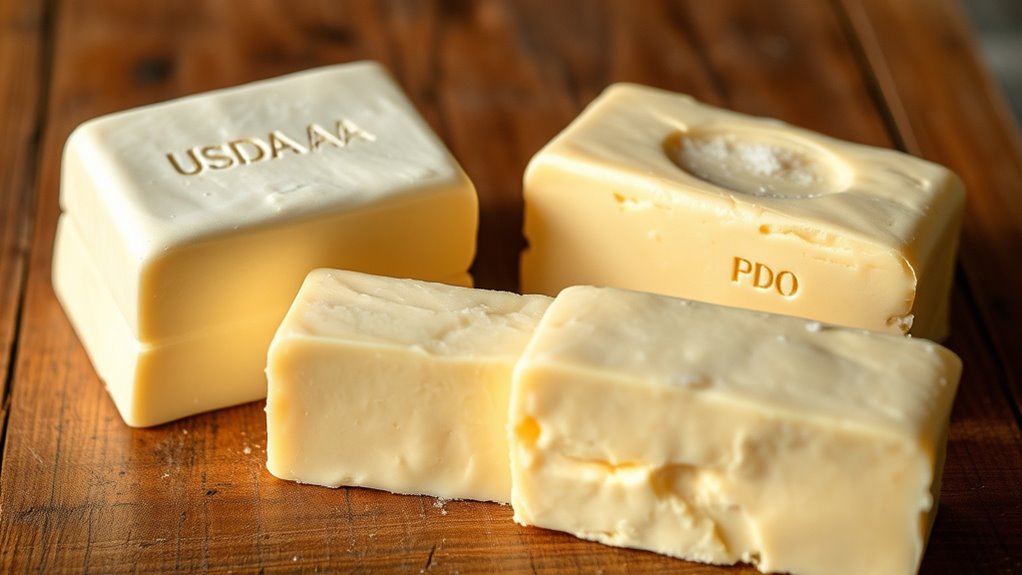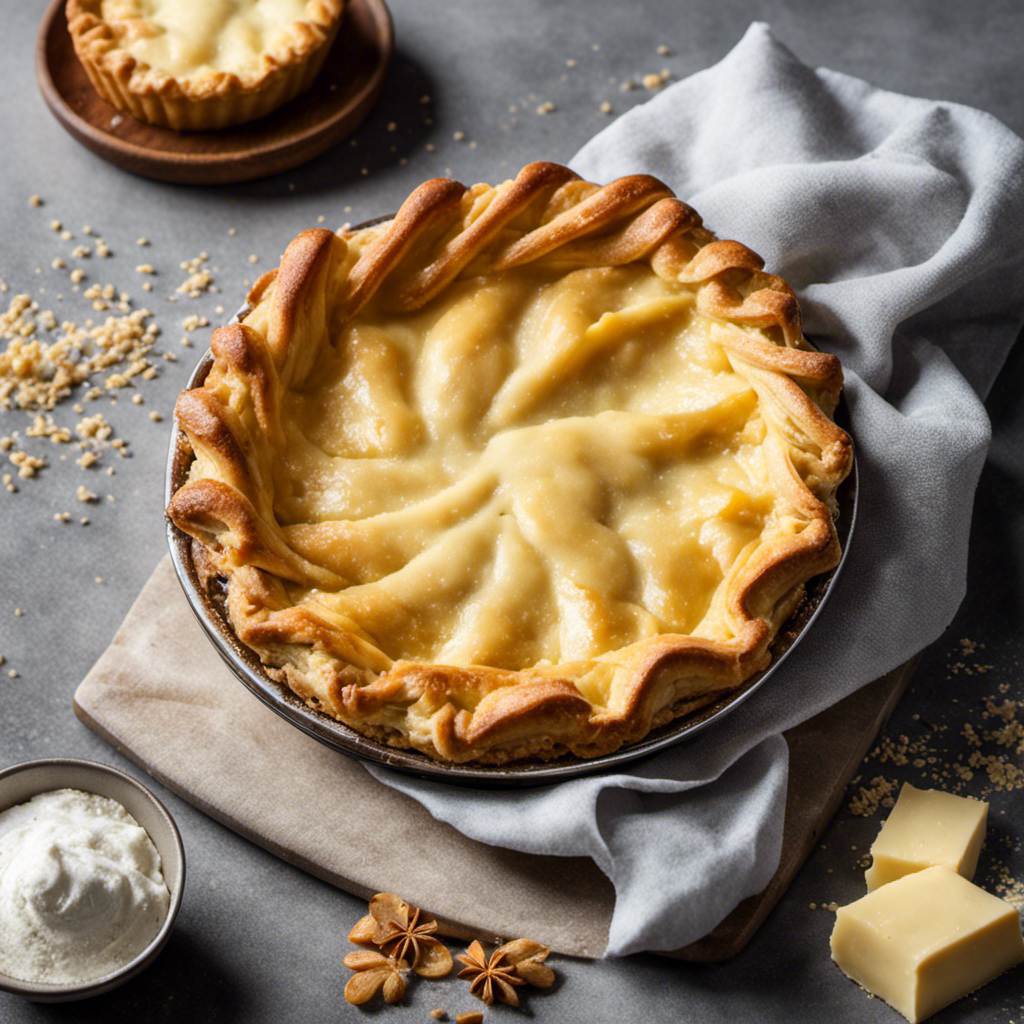Understanding butter grades from USDA AA to European PDO helps you recognize quality based on production standards, regional origins, and processing methods. USDA AA butter is the highest grade, featuring superior flavor, appearance, and texture, while European PDO products emphasize traditional techniques and regional authenticity. Factors like fat content, packaging, and source impact quality. To learn how these standards influence flavor and culinary use, keep exploring these grading systems in detail.
Key Takeaways
- USDA AA butter is the highest American grade, emphasizing superior flavor, appearance, and texture, often used in premium culinary applications.
- European PDO standards certify regional authenticity, traditional methods, and consistent quality, emphasizing cultural heritage and flavor.
- Butter grading considers factors like fat content, appearance, texture, and handling, impacting flavor, richness, and culinary suitability.
- Proper production, packaging, and milk source (e.g., pasture-fed cows) critically influence butter’s quality and grading outcomes.
- Higher-grade butters (USDA AA, PDO) offer richer flavor and better appearance, ideal for specialized cooking, baking, and gourmet uses.
The USDA Grading System: What Does AA Mean?
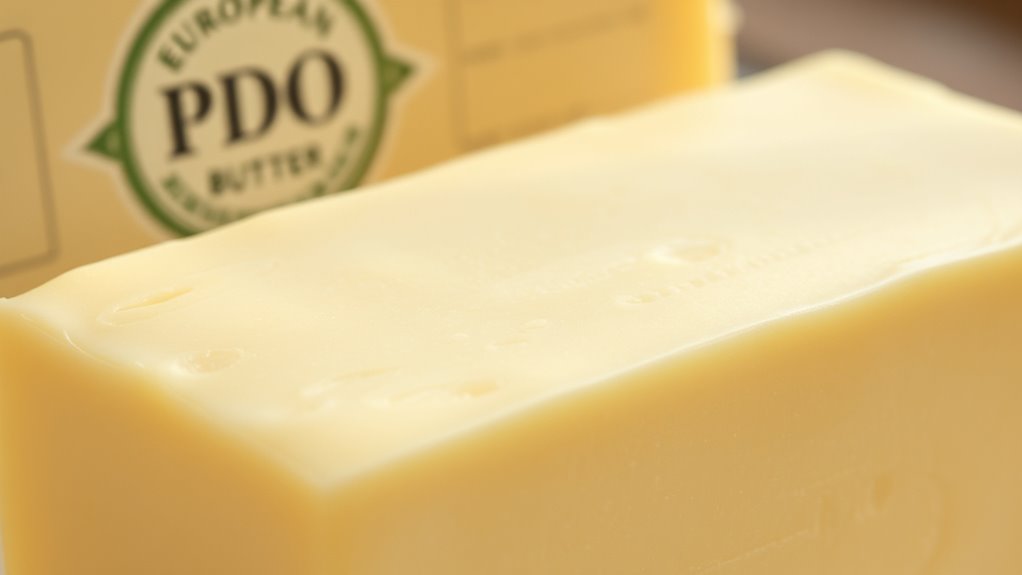
When you see the grade “AA” on USDA butter, it indicates the highest quality available. This grade signifies exceptional butter with superior butter flavor profiles, characterized by a clean, fresh taste and a smooth, creamy texture. USDA AA butter is often produced with strict standards, ensuring consistency and premium quality. Packaging innovations also play a role, helping preserve freshness and flavor, which is essential for maintaining its top-tier status. These advancements include airtight seals and opaque wraps that prevent oxidation and spoilage. As a result, you can expect USDA AA butter to deliver a rich, pure flavor experience, making it ideal for culinary uses where quality truly matters. This grading assures you’re getting butter that’s both flavorful and well-packaged for maximum freshness. Additionally, inspirational quotes about fatherhood remind us of the importance of care and dedication, much like the careful handling that preserves butter quality.
Factors Influencing Butter Quality in USDA Grades

Your butter’s quality depends on factors like fat content standards, which impact richness and texture. The color and appearance also play a role in how appealing it looks, while texture and consistency determine its spreadability. Understanding these elements helps you appreciate what sets USDA grades apart. Additionally, the butter’s storage conditions influence its freshness and overall quality over time.
Fat Content Standards
Have you ever wondered how butter quality is judged across different grades? One key factor is fat content standards. Higher-grade butters, like USDA AA, must meet strict minimum fat percentages, ensuring a rich, creamy texture. This influences the butter aroma, making it more appealing and consistent. Fat content also affects how butter responds in baking and cooking, so producers carefully control this aspect. Packaging design plays a role, too, as it helps preserve the butter’s quality and prevent moisture loss, which can alter fat levels and aroma. Additionally, automation in production helps maintain precise fat measurements and consistent quality across batches. If fat content falls below standards, butter may be downgraded, regardless of its appearance. By maintaining precise fat levels, producers ensure each grade delivers the expected flavor, texture, and aroma that consumers associate with premium butter.
Color and Appearance
Ever wondered how the appearance of butter influences its grade? The key factors include:
- Color uniformity, which signals freshness and affects perceived butter flavor.
- Brightness and gloss, indicating proper processing and quality.
- Smooth, clean surface without cracks or discoloration, reflecting good handling and storage.
A consistent, appealing color and appearance enhance your butter’s visual appeal and consumer confidence. Packaging design also plays a role by protecting the butter from light and air, helping maintain its color and overall look. When these factors align, the butter appears fresh and inviting, often correlating with higher grades. Remember, good appearance isn’t just about looks—it’s a visual cue for quality, influencing taste expectations and perceived butter flavor. Visual appeal is an important aspect that can influence consumer preferences and perceived quality.
Texture and Consistency
Texture and consistency are critical factors that directly influence butter’s grade because they reflect its manufacturing quality and handling. Smooth, firm butter indicates proper processing and storage, enhancing butter flavor and melting point stability. Poor texture, such as grittiness or excessive softness, can signal defects affecting overall quality. Uniform consistency ensures even melting and ideal sensory experience. The melting point, influenced by fat composition, also impacts texture—higher melting points create firmer butter, while lower ones result in softer butter. Consider the following factors:
| Aspect | Impact on Quality | Effect on Grade |
|---|---|---|
| Texture | Smoothness, firmness | Higher grade with better texture |
| Consistency | Uniformity across batches | Consistent butter improves grade |
| Melting Point | Influences firmness and butter flavor | Proper melting point signifies quality |
Additionally, the fat composition of butter plays a significant role in determining its sensory qualities and overall grade.
European Butter Classifications and PDO Designations
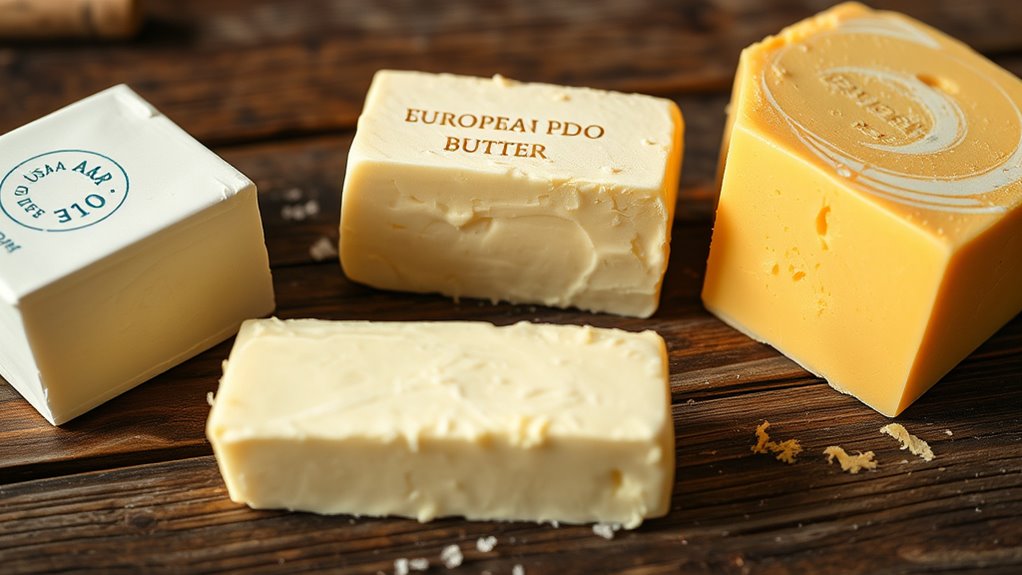
European butter classifications are highly regulated, with specific standards that distinguish each type based on quality, origin, and production methods. These classifications often influence butter flavor profiles and packaging innovations, ensuring authenticity and quality. You should know that:
European butter classifications are strictly regulated, ensuring authentic flavors, traditional methods, and regional packaging excellence.
- PDO (Protected Designation of Origin) guarantees butter is made in a specific region using traditional methods, preserving unique flavor profiles.
- PDO products often feature distinctive packaging innovations that reflect regional heritage, enhancing consumer appeal.
- Classifications like PDO help you identify high-quality butters with consistent flavor, texture, and origin, making your choice more informed.
- The detailed standards set for each classification can also influence production methods, ensuring consistency and authenticity across batches.
Understanding these classifications helps you appreciate the nuances in European butter, from its rich flavor profiles to its traditional packaging, ensuring you select authentic, high-quality products.
Comparing USDA AA and European PDO Standards
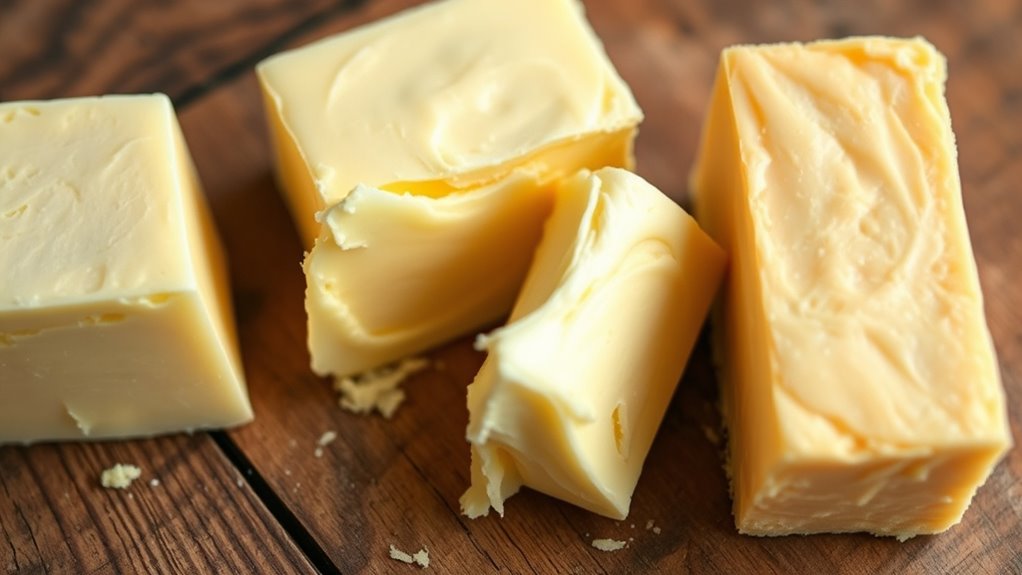
While USDA AA and European PDO standards both aim to guarantee high-quality butter, they differ markedly in their criteria and evaluation methods. USDA AA emphasizes butter flavor, texture, and consistency, focusing on sensory qualities and uniformity. It also considers packaging design, ensuring it preserves freshness and meets safety standards. In contrast, European PDO standards prioritize traditional production methods, regional authenticity, and specific geographic origins. These standards include strict guidelines on butter flavor and production techniques, with less emphasis on packaging design. The USDA grading process involves visual and taste tests, while PDO certification relies heavily on regional and artisanal practices. Additionally, grading criteria for USDA AA involve detailed inspections of each batch, whereas PDO certification is more focused on adherence to traditional methods and regional origin. Overall, USDA AA offers a more standardized approach, whereas European PDO emphasizes tradition and regional identity.
The Role of Fat Content and Texture in Grading
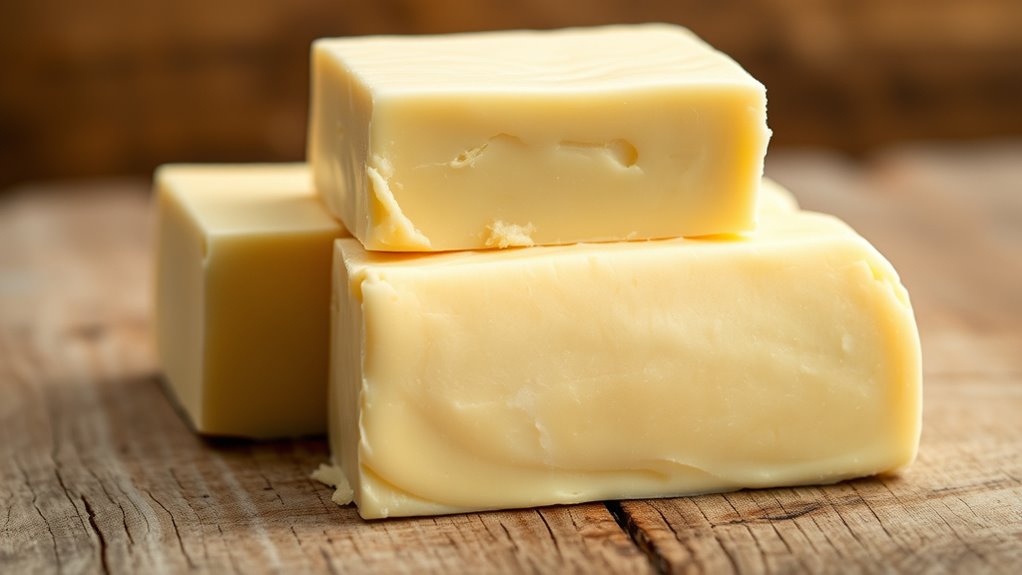
Fat content and texture are critical factors in butter grading because they directly influence quality, spreadability, and mouthfeel. Higher fat levels typically enhance butter flavor, making it richer and more appealing. Texture impacts how easily butter spreads and melts, affecting your overall experience. When evaluating butter, consider these key points:
- Fat content: Determines richness and flavor intensity.
- Texture: Influences smoothness, firmness, and ease of spreading.
- Packaging design: Reflects and preserves butter quality, often hinting at fat content and texture.
Together, these factors guide grading and consumer perception, with a focus on butter’s sensory attributes and how well it maintains its quality during packaging and storage. Your choice of butter depends on understanding these elements and their role in delivering the best butter flavor.
How Production Methods Affect Butter Grades

Your butter’s grade is heavily influenced by how it’s produced. The quality of the milk you use, along with specific processing techniques, plays a vital role. Understanding these methods helps explain the differences in butter grades worldwide. Implementing quality assurance practices during production ensures consistent product standards and can positively impact the final grade.
Production Techniques Impact Quality
Production techniques play a crucial role in determining butter quality and grade. Your choice of methods influences key aspects like butter aroma, texture, and appearance. Consider these factors:
- Churning process – Proper churning ensures smooth texture and enhances butter aroma by preserving fresh dairy notes.
- Temperature control – Maintaining ideal temperatures prevents unwanted flavors and maintains consistency in butter grades.
- Packaging standards – Using quality packaging safeguards against contamination and preserves freshness, directly impacting butter aroma and overall quality.
Milk Source Influences Grade
The source of milk considerably affects butter grades because the quality and composition of the milk directly influence the final product. Milk from different sources varies in fat content, flavor, and purity, which impacts butter’s grading. For example, pasture-fed cows produce milk with higher levels of beneficial fats and a distinctive flavor profile, often resulting in superior butter quality. Milk from pasture-fed herds tends to have more natural nutrients and fewer contaminants, leading to better grading outcomes. Conversely, milk from confined or grain-fed cows may contain additives or lower fat levels, affecting butter’s texture and flavor negatively. Your choice of milk source plays a vital role in achieving high-grade butter, as pasture feeding often enhances both the sensory qualities and overall grading standards of the final product. Additionally, the nutritional profile of the milk, influenced by the cows’ diet, directly affects the butter’s richness and quality.
Processing Methods and Standards
Processing methods and standards play a crucial role in determining butter grades because they directly influence the product’s texture, flavor, and purity. Your choice of dairy fermentation techniques impacts the acidity, consistency, and flavor profile, affecting grade classification. Packaging innovations also matter, as modern methods help preserve freshness and prevent contamination. Consider these key factors: 1. Dairy fermentation controls bacteria activity, shaping flavor and texture. 2. Standardized processing methods ensure uniform quality across batches. 3. Advanced packaging techniques extend shelf life and maintain butter purity. Traditional techniques and regional variations also contribute to differences in butter quality, reflecting the diverse cultural heritage and historical practices in butter production.
Recognizing Quality Through Packaging and Labeling

When evaluating butter quality, paying close attention to packaging and labeling can provide valuable clues. Packaging innovation often reflects a product’s freshness and handling, with sealed, airtight containers protecting quality and extending shelf life. Look for packaging that’s clean, well-sealed, and free from damage, indicating careful processing. Label accuracy is equally important; trustworthy labels specify the butter’s grade, origin, and production date, ensuring transparency. Authentic European PDO or USDA grades are often prominently displayed, confirming quality standards. Clear, truthful labels help you distinguish premium products from lower-grade options. By scrutinizing packaging and labeling, you can better assess butter’s freshness, origin, and adherence to quality standards, making more informed purchasing decisions that align with your culinary expectations.
Selecting the Right Butter for Culinary Uses Based on Grades
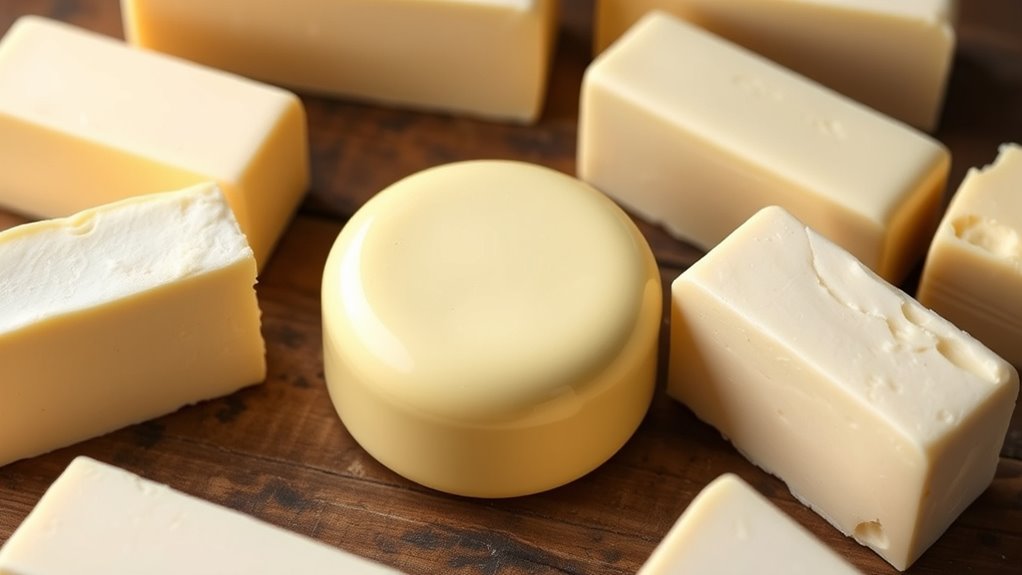
Choosing the right butter for your culinary needs depends heavily on its grade, as each offers different qualities suited to specific uses. Higher grades like USDA AA or European PDO typically have a richer butter flavor and cleaner taste, perfect for baking and delicate sauces. Lower grades may work better for cooking where flavor nuances are less critical. When selecting butter:
- Consider the intended dish—premium grades enhance baked goods and finishing touches.
- Pay attention to packaging design—more attractive packaging often indicates higher quality and better butter flavor.
- Match the butter’s grade with your technique—delicate recipes benefit from high-grade butter, while everyday cooking can use more economical options.
Choosing the right grade guarantees superior flavor, texture, and application, elevating your culinary results.
Trends and Changes in Butter Grading Practices
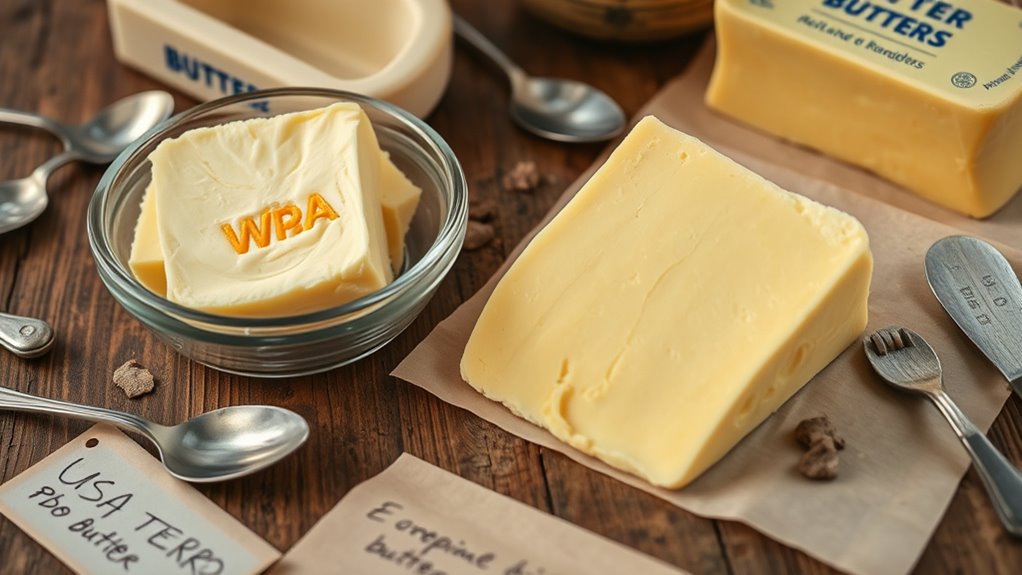
Recent shifts in consumer preferences and technological advancements have prompted significant changes in butter grading practices worldwide. You now see a greater emphasis on butter storage conditions, which help maintain quality and consistency during grading. As freshness becomes a key factor, grading systems increasingly consider factors like moisture content and flavor stability, aligning with consumer demands for premium products. Marketing strategies also influence grading practices, with producers highlighting specific grades to appeal to niche markets, such as European PDO or USDA AA. These trends push for more transparent and standardized grading, ensuring quality across borders and boosting consumer confidence. Overall, evolving practices reflect a focus on quality preservation, better storage, and targeted marketing, shaping how butter grades are determined and communicated globally.
Frequently Asked Questions
How Do Cultural Preferences Influence Butter Grading Standards Worldwide?
Cultural taste preferences substantially influence butter grading standards worldwide. You’ll notice regional grading variations because each culture values different qualities, like creaminess or saltiness, which shape standards. For example, some regions prioritize appearance and texture, while others focus on flavor. These preferences lead to diverse grading criteria, reflecting local traditions and tastes. So, your perception of quality depends on where you are, highlighting how culture shapes butter grading standards globally.
Are There Health Implications Tied to Specific Butter Grades?
You might wonder if certain butter grades affect your health. While grades mainly reflect quality, some higher-fat or less processed butters could influence cholesterol levels, especially if you have a butter allergy or are concerned about cholesterol effects. Eating in moderation and choosing butter with healthier fats can help manage these risks. Always check labels and consult your doctor if you have specific health concerns related to butter consumption.
How Does Storage Impact the Quality of Different Butter Grades?
You might worry about wasting butter, but proper storage guarantees freshness preservation across all grades. Keep butter in airtight containers and store it in a cool, dark place, or refrigerate for longer shelf life. Good storage conditions prevent spoilage and maintain its flavor and texture. So, no matter the grade—USDA AA or European PDO—careful storage helps you enjoy butter at its best, avoiding unnecessary waste and disappointment.
Can Butter Grades Indicate Environmental Sustainability Practices?
You might wonder if butter grades reflect environmental sustainability practices. While higher grades like USDA AA or European PDO often indicate quality, they don’t necessarily reveal dairy farming’s environmental impact. However, some certifications and labels focus on sustainable practices, so look for those. By choosing butter from farms committed to eco-friendly dairy farming, you support better environmental outcomes, even if the traditional grading system doesn’t directly measure sustainability.
What Innovations Are Emerging in Butter Grading Technologies?
Did you know that the global butter market is expected to grow by 5% annually? Emerging innovations in butter grading technology include butter grading automation and digital quality assessment, which improve accuracy and efficiency. These advancements allow producers to quickly determine butter quality, ensuring consistency. As a result, you benefit from better products and more transparent standards, making butter grading more reliable and accessible than ever before.
Conclusion
Think of butter grading like a journey through a flavorful landscape. Your choice guides you through lush pastures of quality, from USDA AA’s pristine peaks to European PDO’s cherished valleys. By understanding these grades, you’re the seasoned traveler, steering your culinary adventure with confidence. Embrace the variety, trust the labels, and let your taste buds explore the rich terrain of butter’s world—where every grade open a new delight.
